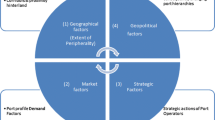Abstract
There is a need to move from discussing the Asia-Pacific Rim's leading port cities as shipping centres measured by container throughput. This shift in focus involves examining how different transport and telecommunications systems are interacting with each other at an international scale under the power and control of major world operators. Using a three-level network framework an attempt is made to illustrate and explain the formation of multilayered trade/communications corridors and hubs/headquarters in the Asia-Pacific Rim since the mid-1980s and to identify the factors affecting them. From this examination of spatial structure and corporate control three levels of cities in the Asia-Pacific Rim are recognised: first level cities with strong corporate representation in container shipping, air cargo, air passenger and telecommunications; second level cities with marked corporate representation in one but not all four modes; and third level cities with no marked corporate representation in any mode but with strong throughput. The third level includes the Asia-Pacific Rim's ‘true’ port cities. Perhaps the ambiguous category ‘port city’ should be reserved for them.
Similar content being viewed by others
References
AS, 1977: Singapore Air rethinks cargo strategy. American Shipper, February: 68.
Anderson S.L., 1997: Japan's information technology and developmentalism in Asia-Pacific cities and the region. Unpublished paper presented at the E*Space Workshop on Digital Cities-Analog World, Singapore/Kuala Lumpur, 11–16 May 1997.
Baird A.J., 1999: Container vessels of the next generation: Are seaports ready to face the challenge? Unpublished paper presented at the 21st World Ports Conference of the International Association of Ports and Harbors, Port Klang, Malaysia, 15–21 May 1999.
CIY, 1987–1997: Containerisation International Yearbook. The National Magazine Co. Ltd. London, Annual.
Cheng L.K. & Wong Yue-Chim R. 1997: Port Facilities and Container Handling Services. The Hong Kong Economic Policy Study Series. City University of Hong Kong, Hong Kong.
Damas P., 1998. Alliances focus on fast transits. American Shipper, March: 8-17.
Dick H.W., 1996: International airlines and container shipping: A comparison of long-run competitive dynamics. In: Dick H. (ed.), Airline Deregulation in the Asia-Pacific: Towards Open Skies. Institute of Transport Studies, Sydney: pp. 17-32.
EC, 1995: Blue skies, red ink, black future. Economist 335(7913): 67-69.
Findlay C., 1996: Airline competitiveness in regulatory reform. In: Dick H. (ed.), Airline Deregulation in the Asia-Pacific: Towards Open Skies. Institute of Transport Studies, Sydney, pp. 7-16.
Forsyth P. 1996: Competitiveness and productivity in Asia-Pacific aviation. In: Dick H. (ed.), Airline Deregulation in the Asia-Pacific: Towards Open Skies. Institute of Transport Studies, Sydney, pp. 53-62.
Hayuth Y., 1981: Containerisation and the load centre concept. Economic Geography 57(2): 160-176.
Hooper P., 1996: Airline markets in Asia: The domestic/international regulatory interface. In Dick H. (ed.), Airline Deregulation in the Asia-Pacific: Towards Open Skies. Institute of Transport Studies, Sydney, pp. 33-56.
IATA, 1986–1996: World Air Transport Statistics. International Air Transport Association, Cointrin-Geneva: Montreal Annual.
ICAO, 1986–1996: Civil Aviation Statistics of the World. International Civil Aviation Organization Montreal Annual.
ICAO, 1997: Report of the Asia/Pacific Area Traffic Forecasting Group: Sixth Meeting Bangkok, 20–29 May 1996. International Civil Aviation Organization ICAO, Montreal.
Mansell R., 1994: A networked economy: unmasking the ‘globalisation’ thesis. Telematics and Informatics 11(1): 25-43.
NYK, 1986, 1991, 1996: World Containerisation Fleet and its Operations. NYK Research Group, Tokyo.
Notteboom T. & Winkelmans W., 1999: Re-assessing the role of port authorities in the 21st century. Unpublished paper presented at the 21st World Ports Conference of the International Association of Ports and Harbors, Port Klang, Malaysia, 15–21 May 1999.
Oum T.H., 1998: The air transport system in Northeast Asia. Unpublished paper presented at EWC/KOTI Conference on Strategies for Developing a Regional Transportation and Logistics System in Northeast Asia, East-West Center, Honolulu, Hawaii, 13–14 August 1998.
Oum T.H. & Taylor A.J., 1995: Emerging patterns in intercontinental air linkages and implications for international route allocation policy. Transportation Journal, 34(4): 4-27.
Oum T.H., Taylor A.J. & Zhang A., 1993: Strategic airline policy in the globalizing of air networks. Transportation Journal 32(3): 14-30.
PAH, 1998: Science of alliance 2: Profits return? Ports and Harbors, June, 19-25.
PECC, 1995: Air Transport in the Asia-Pacific: Challenges, Opportunities and Options. Summary Conference Report. Singapore PECC Member Committees of Australia, Chile, Korea and Singapore. 9-11 July 1995.
Paré E., 1997: Telecommunications Directory. Gale, Detroit, 8th edition.
Rimmer P.J., 1991: The internationalisation of the Japanese freight forwarding industry. Asian Geographer, Special Issue on Japan 10(1): 17-38.
Rimmer P.J., 1996: Airlines as information networks: Qantas and Singapore. In: Dick H. (ed.), Airline Deregulation in the Asia-Pacific: Towards Open Skies. Institute of Transport Studies, Sydney, pp. 63-92.
Rimmer P.J. (ed.), 1997a: Global network firms in transport and communications: Japan's NYK, KDD and JAL? Pacific Rim Development: Integration & Globalisation in the Asia-Pacific Economy. Allen & Unwin, Sydney, pp. 83-114.
Rimmer P.J., 1997b: Shipping patterns in the Western Pacific-the China factor. Maritime Studies 94 1-27.
Rimmer P.J., 1997c: US Western Pacific geostrategy: Subic Bay before and after withdrawal. Marine Policy 21(4): 325-344.
Rimmer P.J., 1997d: The Trans-Pacific oceanic economy revisited: goods movement, business travel and regional platforms. Tijdschrift voor Economische en Sociale Geografie. 88: 439-453.
Rimmer P.J.; 1998a: Impact of global strategic alliances on Pacific Rim seaports. Maritime Studies 98: 1-29.
Rimmer P.J., 1998b: Ocean liner shipping services: corporate restructuring and port selection and competition. Asia-Pacific Viewpoint 39(2): 193-208.
Rimmer P.J. & Morris-Suzuki T., 1999: The Japanese internet: visionaries and virtual democracy. Environment and Planning A 31(7): 1189-1206.
Robinson R., 1997: Asian hub/feeder nets: The dynamics of restructuring. Working Paper ITS-WP-97-5. Institute of Transport Studies, Sydney.
Schwieterman J.P., 1993: Air Cargo and the Opening of China: New Opportunities for Hong Kong Chinese University Press, Hong Kong.
Staple G.C. (ed.), 1991: The Global Telecommunications Traffic Report. International Institute of Communications Washington, D.C.
TGI, 1997: TeleGeography, 1996/97 Global Telecommunications Traffic Statistics and Commentary. TeleGeography Inc., Washington D.C.
Author information
Authors and Affiliations
Rights and permissions
About this article
Cite this article
Rimmer, P.J. The Asia-Pacific Rim's transport and telecommunications systems: spatial structure and corporate control since the mid-1980s. GeoJournal 48, 43–65 (1999). https://doi.org/10.1023/A:1007040820441
Issue Date:
DOI: https://doi.org/10.1023/A:1007040820441



